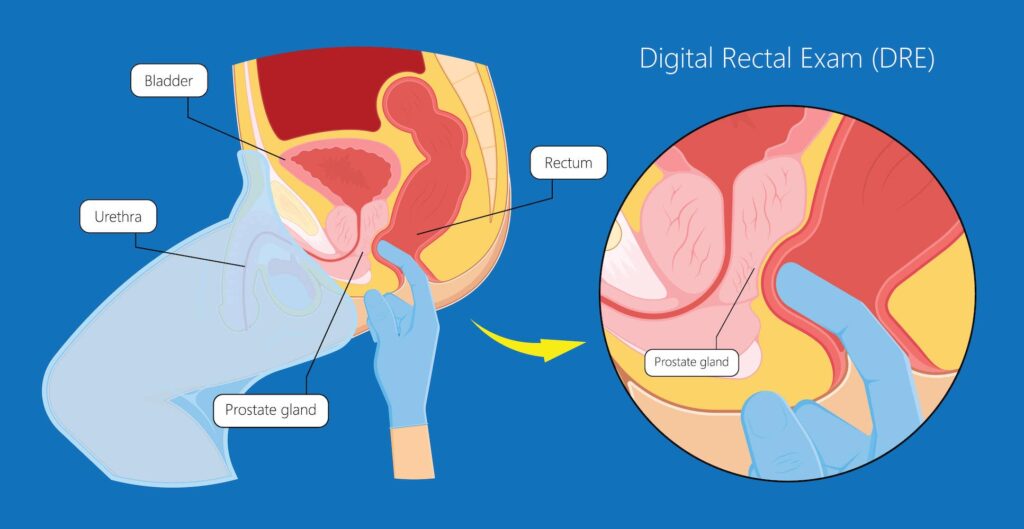在新加坡,前列腺癌是男性第二大普遍癌症,也是全球第五大死因。 前列腺癌的风险随着年龄的增长而增加,尤其是在 50 岁以上的男性中。 值得庆幸的是,前列腺癌是可以根治的。如果及早发现,根治的机率非常高。
前列腺是位于膀胱下方核桃大小的腺体,负责产生精液。 它是受雄性激素睾丸激素的控制。 前列腺癌是异常细胞不受控制的增殖,而导致恶性肿瘤。

如果处于早期阶段,前列腺癌不会引起任何症状。 到了晚期,您可能遇到的症状包括:
如果您遇到上述任何症状,您应该去看医生。 此外,50 岁以上或有前列腺癌家族史的男性可能需要找泌尿科医师以讨论有关前列腺癌筛查。
前列腺癌可根据治疗后复发的风险进行分类,分为低危、中危、高危或极高危前列腺癌。 风险分类取决于以下因素:
下表总结了前列腺癌的不同风险分类。
低风险
● PSA < 10 纳克/毫升并且
● 格里森评分 <7 并且
● 直肠指检正常或可触及的结节,涉及不到前列腺 1 叶的一半
中等风险
● PSA 10-20 纳克/毫升或
● 格里森得分为 7 或
● 直肠指检可触及的结节占前列腺 1 叶
高风险
● PSA > 20 纳克/毫升或
● 格里森评分 > 7 或
● 可触及的结节涉及前列腺双叶
极高风险
● 肿瘤超出前列腺并入侵周围结构或
● 盆腔淋巴结受累
目前尚不清楚导致前列腺癌的原因。 但是,某些情况会增加患前列腺癌的风险。 前列腺癌的危险因素是:
与普遍的看法相反,性生活不是前列腺癌的危险因素。

前列腺癌 可以通过一系列测试来诊断,例如:
有一种血检可以帮助医生估计前列腺癌的可能性。 血液中异常高的 PSA 水平可能因为前列腺发炎、感染、肿大或癌症。
请务必注意,PSA 水平升高并不一定意味着您患有前列腺癌。 您的泌尿科医生可能会进行进一步检查或活组织检查加以确诊。
无需准备。 但是,如果您有任何疾病,例如痔疮或肛裂,请告知您的医生,因为这些情况可能会导致检查过程中出现不适。
前列腺癌的治疗因癌症的风险分类和分期而异。
主动监测包括密切监测癌症的进展。 这有助于避免不必要的治疗,进而避免治疗相关的并发症,例如勃起功能障碍和尿失禁。 对于低风险的早期前列腺癌,可能建议进行主动监测。 主动监测包括定期验血、直肠检查和前列腺活检,以监测癌症的进展。 如果癌症有进展的迹象,将及时给予治疗。
早期前列腺癌是指尚未扩散到其他组织或器官的癌症。
晚期前列腺癌是指已经扩散到其他组织或器官的癌症。 治疗方案包括
可以的。如果及早发现和治疗,前列腺癌是可以治愈的。 早期诊断意味着早期治疗并提高完全康复机会。 研究显示,被诊断患有早期低度和中度前列腺癌的男性的 5 年生存率为 95-99%。 当前列腺癌扩散到身体的其他部位时,这个百分比下降到 31%。
与普遍看法相反,机器人辅助手术并非由机器人独立完成,而是由经验丰富的外科医生通过控制台引导机器人完成整个手术过程。 与传统技术相比,机器人辅助可为外科医生提供更好的视像、灵巧性和控制。
此外,机器人辅助手术允许使用小切口进入难以到达的区域。 这会降低并发症的风险并缩短恢复时间。
前列腺癌 is known to be one of the most common cancers in men. Although different individuals may experience different symptoms, most do not have any symptoms at all (especially in the early stages). But there can still be a number of warning signs that one must be aware of, such as:
In addition to these symptoms, some patients may also experience symptoms such as pain and numbness in their legs and other parts of the body, a new onset of erectile dysfunction, and blood in the semen. Therefore, if you experience any of these warning signs, it is important to consult an experienced prostate specialist 在新加坡 to assess you thoroughly so that treatment can be started right away.
Prostate cancer in Singapore is one of the most successfully treated cancers, especially in its early stages. If this cancer is diagnosed and managed early, the prognosis tends to be more favourable. Most prostate specialists in Singapore may use a series of investigations to help them confirm the diagnosis. These tests typically include the prostate-specific antigen blood test (PSA), digital rectal examination (DRE), ultrasound scans, and magnetic resonance imaging (MRI).
Active surveillance plays an integral role in prostate cancer treatment in Singapore (low-risk cancers). For more aggressive prostate cancers, the management plan will depend on the grade, stage, and risk classification of the cancer. Treatment usually involves surgery and radiation therapy, which is beneficial in treating localised cancers. The main treatment for prostate cancer is radical prostatectomy and it involves removing the entire prostate gland, including the seminal vesicles. If needed, the lymph nodes may also have to be removed.
This procedure may also be carried out laparoscopically or by robot-assisted surgery. However, it must be noted that not all surgeons can perform 机器人手术; only a 泌尿科医生 who has been trained with the necessary skills can carry out this procedure.
Unfortunately, yes. If the cancer is detected late or left untreated, it has the potential to become life-threatening. However, this is not the case for most prostate cancers, as they usually grow slowly and stay confined to the prostate gland. These patients usually have a very good chance of survival if 治疗 是 commenced promptly. However, those with more aggressive types of prostate cancer may find that the cancer spreads quickly, making management challenging especially in the advanced stages. These cancers will require prompt radical treatment in the form of surgery and/or radiotherapy for the optimal outcomes. Therefore, it is vital to consult a urologist with the experience of treating such advanced cancers.
Prostate cancer in Singapore is the second most commonly diagnosed cancer in males and is typically seen in those over the age of 50. It also has a significant mortality rate, especially for untreated cases in their advanced stages, emphasising the need for early detection and treatment. When it comes to the life expectancy of a person with prostate cancer, those with low Gleason grades are expected to have a 5-year survival rate of over 95%. Conversely, patients whose cancer has spread (metastasised) may have lower survival rates.
The Gleason score is a measure of how aggressive the cancer cells are, and they are graded on a scale of 1 to 5. However, each area of the prostate cancer assessment may have different scores, so the pathologist will examine the cancer cells to determine the most common grades and these will be added to achieve the final score. For instance, if an individual’s largest area with cancer is Grade 3 and another large area indicates Grade 4, the Gleason score for this sample would be 3+4=7. The higher the score, the more aggressive the cancer is. A score of 6 would denote a non-aggressive type of cancer, while a score of 8 and above will indicate that the person may have a highly aggressive form of prostate cancer.
As mentioned previously, the survival rates for localised prostate cancers in the early stages are considerably high. According to data obtained from the American Society of Clinical Oncology, the estimated survival rate for 10 to 15 years after treatment ranges between 95% to 98% (for localised cancers). Although the survival rates for those with distant metastasis (spread to other organs) aren’t usually favourable, aggressive treatment may help them survive their condition for more than five years.
Need more information? Reach out to our team at Assure 泌尿外科和机器人中心 today and book an appointment with one of the finest and most reputed prostate specialists in Singapore.
癌症对大多数人来说是非常可怕,但早期发现和治疗,前列腺癌是可以治愈的。 如果您怀疑自己可能患有前列腺癌,请去看泌尿科医生,或者如果您患前列腺癌的风险较高,请定期进行筛查。

MBBS, MRCSed, MMED(外科)
林诗杰医生是泌尿外科高级顾问,他较擅长泌尿肿瘤学专科。 他是安顺泌尿外科中心 (Assure Urology & Robotic Centre) 的医疗主管。 他的临床兴趣包括泌尿肿瘤学、微创与机器人辅助泌尿外科手术、泌尿结石病和前列腺健康。
在开办顺泌尿外科中心之前,林诗杰医生在公共医院工作了近 20 年。 他曾担任樟宜综合医院(Changi General Hospital)泌尿外科的高级顾问,副教授和部门主任。 他目前是的樟宜综合医院客座顾问。 林医生曾是樟宜综合医院先进外科中心的主任,该中心主要处理复杂手术(包括机器人手术)。

MBBS, MRCSed, MMED(外科)
林诗杰医生是泌尿外科高级顾问,他较擅长泌尿肿瘤学专科。 他是安顺泌尿外科中心 (Assure Urology & Robotic Centre) 的医疗主管。 他的临床兴趣包括泌尿肿瘤学、微创与机器人辅助泌尿外科手术、泌尿结石病和前列腺健康。
在开办顺泌尿外科中心之前,林诗杰医生在公共医院工作了近 20 年。 他曾担任樟宜综合医院(Changi General Hospital)泌尿外科的高级顾问,副教授和部门主任。 他目前是的樟宜综合医院客座顾问。 林医生曾是樟宜综合医院先进外科中心的主任,该中心主要处理复杂手术(包括机器人手术)。
如果您对自己的状况或我们的服务有任何疑问,请随时通过WhatsApp与我们联系。
请联系我们以获得泌尿外科专家护理。
如有任何询问请留言,我们友善的服务人员会尽快与您联络。
对于办公时间以外的紧急查询,请致电或通过 WhatsApp 联系我们: (65) 9835 0668.
星期一至星期五: 上午 9:00 – 下午 5:00
星期六: 上午 9:00 – 中午 12:30
星期天和公定假日: 关闭

© 2023 版权所有 | Assure 泌尿外科和机器人中心 | 条款及条件